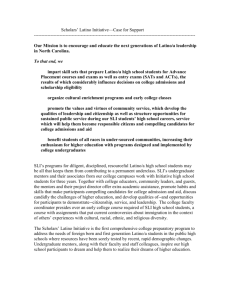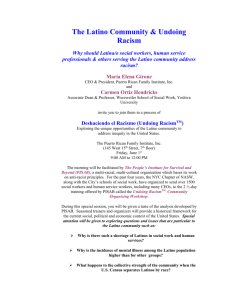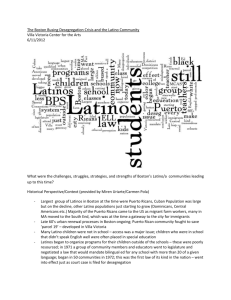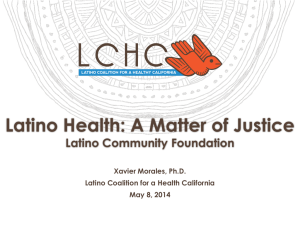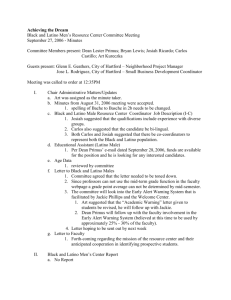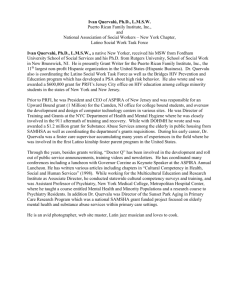Cambridge University Press 978-0-521-19897-4
advertisement
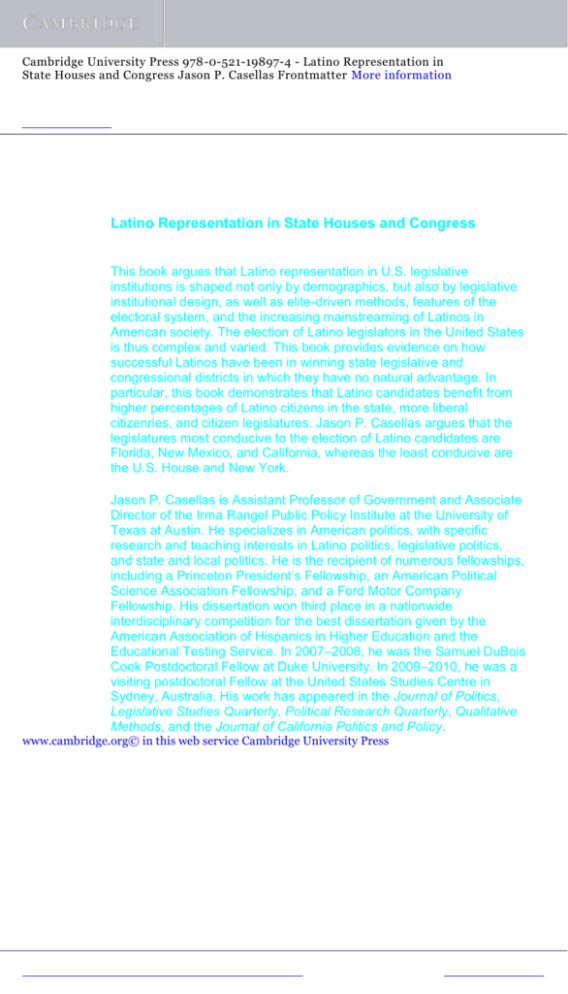
Cambridge University Press 978-0-521-19897-4 - Latino Representation in State Houses and Congress Jason P. Casellas Frontmatter More information Latino Representation in State Houses and Congress This book argues that Latino representation in U.S. legislative institutions is shaped not only by demographics, but also by legislative institutional design, as well as elite-driven methods, features of the electoral system, and the increasing mainstreaming of Latinos in American society. The election of Latino legislators in the United States is thus complex and varied. This book provides evidence on how successful Latinos have been in winning state legislative and congressional districts in which they have no natural advantage. In particular, this book demonstrates that Latino candidates benefit from higher percentages of Latino citizens in the state, more liberal citizenries, and citizen legislatures. Jason P. Casellas argues that the legislatures most conducive to the election of Latino candidates are Florida, New Mexico, and California, whereas the least conducive are the U.S. House and New York. Jason P. Casellas is Assistant Professor of Government and Associate Director of the Irma Rangel Public Policy Institute at the University of Texas at Austin. He specializes in American politics, with specific research and teaching interests in Latino politics, legislative politics, and state and local politics. He is the recipient of numerous fellowships, including a Princeton President’s Fellowship, an American Political Science Association Fellowship, and a Ford Motor Company Fellowship. His dissertation won third place in a nationwide interdisciplinary competition for the best dissertation given by the American Association of Hispanics in Higher Education and the Educational Testing Service. In 2007–2008, he was the Samuel DuBois Cook Postdoctoral Fellow at Duke University. In 2009–2010, he was a visiting postdoctoral Fellow at the United States Studies Centre in Sydney, Australia. His work has appeared in the Journal of Politics, Legislative Studies Quarterly, Political Research Quarterly, Qualitative Methods, and the Journal of California Politics and Policy. www.cambridge.org© in this web service Cambridge University Press Cambridge University Press 978-0-521-19897-4 - Latino Representation in State Houses and Congress Jason P. Casellas Frontmatter More information Latino Representation in State Houses and Congress JASON P. CASELLAS University of Texas, Austin www.cambridge.org© in this web service Cambridge University Press Cambridge University Press 978-0-521-19897-4 - Latino Representation in State Houses and Congress Jason P. Casellas Frontmatter More information cambridge university press Cambridge, New York, Melbourne, Madrid, Cape Town, Singapore, São Paulo, Delhi, Dubai, Tokyo, Mexico City Cambridge University Press 32 Avenue of the Americas, New York, ny 10013-2473, usa www.cambridge.org Information on this title: www.cambridge.org/9780521198974 © Jason P. Casellas 2011 This publication is in copyright. Subject to statutory exception and to the provisions of relevant collective licensing agreements, no reproduction of any part may take place without the written permission of Cambridge University Press. First published 2011 Printed in the United States of America A catalog record for this publication is available from the British Library. Library of Congress Cataloging in Publication data Casellas, Jason Paul, 1977– Latino representation in state houses and Congress / Jason P. Casellas. p. cm. Includes bibliographical references and index. isbn 978-0-521-19897-4 (hardback) 1. Legislative bodies – United States. 2. Legislative bodies – United States – States. 3. United States. Congress. 4. Hispanic American legislators. 5. Hispanic Americans – Politics and government. I. Title. jk2495.c37 2011 328.73008968–dc22 2010031213 isbn 978-0-521-19897-4 Hardback Cambridge University Press has no responsibility for the persistence or accuracy of urls for external or third-party Internet Web sites referred to in this publication and does not guarantee that any content on such Web sites is, or will remain, accurate or appropriate. www.cambridge.org© in this web service Cambridge University Press Cambridge University Press 978-0-521-19897-4 - Latino Representation in State Houses and Congress Jason P. Casellas Frontmatter More information To my parents www.cambridge.org© in this web service Cambridge University Press Cambridge University Press 978-0-521-19897-4 - Latino Representation in State Houses and Congress Jason P. Casellas Frontmatter More information Contents List of Tables page x List of Figures xiii Acknowledgments xv Introduction 1 Latinos in American Society 4 Latino Political Incorporation 9 The Concept of Representation 10 Brief Discussion of Subsequent Chapters 15 1 Latinos in Legislatures: Historical and Theoretical Setting 19 Literature on Latinos in Legislatures 22 Other Minorities in Legislatures and Redistricting 25 Research Questions 28 Types of Data 30 Choice of Legislatures 32 2 The Effects of Population, Turnover, and Term Limits on Latino Representation 33 Turnover, Professionalization, and Term Limits 34 Methods 41 Institutional and Demographic Determinants of Latino Representation 43 Conclusion 46 3 District Composition and the Election of Latino Candidates 51 Redistricting after the Voting Rights Act of 1965 52 Methods 56 United States House 57 vii www.cambridge.org© in this web service Cambridge University Press Cambridge University Press 978-0-521-19897-4 - Latino Representation in State Houses and Congress Jason P. Casellas Frontmatter More information viii Contents Overall Findings 59 New Mexico 63 California 64 Texas 65 Arizona 67 Florida 68 New York 70 New Jersey 72 Conclusion 73 4 Electing Latinos in Non-Latino Majority Districts 76 Methodology 78 The Elite-Driven Process 82 Features of the Electoral System 91 Latino Republicans 101 Conclusion 103 5 Voices from Within: How Latino Legislators See Themselves 106 Methodology 108 Background, Political Past, and Election to Current Position 110 Legislators’ Perceptions of Competitiveness 112 How They View Their Districts 113 Issue Priorities of Latino Legislators 115 Perceptions of Representation 118 Does Partisanship Trump Ethnicity? 120 Conclusion 122 6 Roll Call Voting Behavior of Latino Legislators 125 Background of Latinos in Colorado, New Jersey, and Texas 126 What We Know About Latino Roll Call Voting Behavior 128 Data and Methods 130 Findings 131 Conclusion 136 7 Conclusion 138 Legislatures and Legislators Matter 139 Not All States Are Equal: Institutions and Demographics Matter 140 The Mainstreaming of Latinos in U.S. Legislatures 142 African Americans and Latinos 143 Party Outreach Extends Beyond Presidential Races 143 Latino Pan-Ethnic Identity Despite District Differences 145 Variations in Latino Legislators’ Voting Records 145 www.cambridge.org© in this web service Cambridge University Press Cambridge University Press 978-0-521-19897-4 - Latino Representation in State Houses and Congress Jason P. Casellas Frontmatter More information ix Contents Appendix A 147 Appendix B 149 Appendix C 157 Appendix D 159 Appendix E 161 References 163 Index 175 www.cambridge.org© in this web service Cambridge University Press Cambridge University Press 978-0-521-19897-4 - Latino Representation in State Houses and Congress Jason P. Casellas Frontmatter More information Tables 1.1a Latino Representatives in the U.S. Congress Ranked in Descending Order of Latino Population, 2009 page 20 1.1b Non-Latino Representatives in the U.S. Congress Ranked in Descending Order of Latino Population (40 Percent and Above Districts), 2009 21 1.2 Percentage Latino in Seven States and United States, 1950–2000 (Census Bureau) 21 1.3 Percentage Latino in Seven State Legislatures and Congress, 1986–2002 22 1.4 Literature on Racial and Ethnic Representation in U.S. State Legislatures 23 2.1 Term Limits Legislation in the United States 36 2.2 The Effects of Turnover and Term Limits on Latino Representation, 1992, 1996, 2000, and 2004 44 3.1 Probit Analysis of Latino Representation in State Legislatures and the U.S. House 58 3.2 Probability of a Latino Being Elected to Eight Legislatures, 2003–2004 Citizens 60 3.3 Probability of a Latino Being Elected to Eight Legislatures, 2003–2004 All 61 4.1a Latino Representatives in the United States, 2004 79 4.1b African-American Representatives in the United States, 2004 80 4.2 Two Minority Candidates in General Election 85 x www.cambridge.org© in this web service Cambridge University Press Cambridge University Press 978-0-521-19897-4 - Latino Representation in State Houses and Congress Jason P. Casellas Frontmatter More information xi Tables 4.3 Latino Legislators First Appointed to Seat 87 4.4 Latino Legislators Recruited by Party Leaders 90 4.5 Latino Legislators with Anglo Names 92 4.6 Latino Legislators in Near-Majority Districts (45 Percent and Up) 94 4.7 Latino Legislators in Districts with Combined Latino and African-American Majorities 95 4.8 Latino Legislators Who Initially Won in Multicandidate Primaries 99 5.1 Descriptive Statistics of Interview Subjects 124 6.1 Impact of Latino Representative and Percent Latino on Poole-Rosenthal Scores for Texas House, Colorado Legislature, New Jersey Legislature, and U.S. House, 1999–2002 135 A.1 Probit Analysis of Latino Representation in New Mexico’s Lower Chamber and Entire Legislature, 1991 and 2003 149 A.2 Probability of a Latino Being Elected to the 2003 New Mexico Legislature 149 A.3 Probit Analysis of Latino Representation in California’s Lower Chamber and Entire Legislature, 2000 and 2003 150 A.4 Probability of a Latino Being Elected to the 2003 California Legislature 150 A.5 Probit Analysis of Latino Representation in Texas’s Lower Chamber and Entire Legislature, 2001 and 2003 151 A.6 Probability of a Latino Being Elected to the 2003 Texas Legislature 151 A.7 Probit Analysis of Latino Representation in Arizona’s Lower Chamber and Entire Legislature, 2001 and 2003 151 A.8 Probability of a Latino Being Elected to the 2003 Arizona Legislature 152 A.9 Probit Analysis of Latino Representation in Florida’s Lower Chamber and Entire Legislature, 1996 and 2003 152 A.10 Probability of a Latino Being Elected to the 2003 Florida Legislature 152 A.11 Probit Analysis of Latino Representation in New York’s Lower Chamber and Entire Legislature, 2003 153 www.cambridge.org© in this web service Cambridge University Press Cambridge University Press 978-0-521-19897-4 - Latino Representation in State Houses and Congress Jason P. Casellas Frontmatter More information xii Tables A.12 Probability of a Latino Being Elected to the 2003 New York Legislature 153 A.13 Probit Analysis of Latino Representation in New Jersey’s Lower Chamber and Entire Legislature, 2003 153 A.14 Probability of a Latino Being Elected to the 2003 New Jersey Legislature 154 A.15 Probit Analysis of Latino Representation in the U.S. House, 1995 and 2003 154 A.16 Probability of a Latino Being Elected to the 2003 U.S. House 154 A.17 Probit Analysis of Latino Representation in Seven State Lower Chambers and the U.S. House, 2003–2004 155 A.18 Probit Analysis of Latino Representation in Five State Lower Chambers and the U.S. House, Pre-2000 Redistricting 156 A.19 Probit Analysis of Latino Representation in Seven State Legislatures, 2003–2004 156 A.20 Probit Analysis of Latino Representation in Five State Legislatures, Pre-2000 Redistricting 159 A.21 Impact of Mexican-American and Puerto Rican Representative and Percent Latino on Poole-Rosenthal Score for the 100th Congress 161 A.22 Impact of Cuban-American, Mexican-American, and Puerto Rican Representative and Percent Latino on Poole-Rosenthal Score for the 87th–104th Congresses 162 www.cambridge.org© in this web service Cambridge University Press Cambridge University Press 978-0-521-19897-4 - Latino Representation in State Houses and Congress Jason P. Casellas Frontmatter More information Figures 2.1 Latino representation in state lower houses, 1992 page 35 2.2 Latino representation in state upper houses, 1992 35 2.3 Latino representation in state lower houses, 2000 48 2.4 Latino representation in state upper houses, 2000 48 2.5 Latino representation in state lower houses, 2004 49 2.6 Latino representation in state upper houses, 2004 49 xiii www.cambridge.org© in this web service Cambridge University Press Cambridge University Press 978-0-521-19897-4 - Latino Representation in State Houses and Congress Jason P. Casellas Frontmatter More information Acknowledgments Words cannot express my appreciation to the many people who have given me the encouragement, advice, and invaluable criticisms that have shaped this book. First and foremost, I am most indebted to my dissertation advisor, R. Douglas Arnold, for always being supportive of my work and helping me become a better scholar and writer. His numerous and always detailed critiques of my drafts have undoubtedly made this book much better than it otherwise would have been. I have always been amazed by Doug’s ability to provide timely and, more importantly, quality reactions to my work. This never ceased during my time at Princeton despite a challenge to Doug’s health. Secondly, Tali Mendelberg has been a strong supporter of my project ever since we first talked about it in her offic early on during my graduate career. Tali has had faith in my abilities since she first read my application file in 200 and she has continued her support of my work and provided important feedback despite her taking on important departmental responsibilities as Director of Graduate Studies. Her detailed and incisive commentaries on my work no doubt have made this book much clearer and systematic. I am forever indebted to Tali for her valuable mentorship. Larry Bartels has also served as an important advisor, especially in regards to questions I have had regarding the quantitative aspects of my book. Larry’s knowledge of redistricting, especially in New Jersey, helped inform my book. I am also indebted to other members of the Princeton faculty, including those in attendance at the American Politics Research Seminar where I presented drafts of this project. The staff at CSDP, including Helene Wood and Diane Price, provided years of support, laughter, and surrogate motherly care during my years in graduate school. Monica Selinger at Princeton made my life xv www.cambridge.org© in this web service Cambridge University Press Cambridge University Press 978-0-521-19897-4 - Latino Representation in State Houses and Congress Jason P. Casellas Frontmatter More information xvi Acknowledgments a breeze by always looking out for me and enduring my long conversations in her office about topics ranging from where to go in Italy to the ins and outs of navigating the Princeton bureaucracy. I also thank Princeton University’s Graduate School, especially Dean David Redman and Danielle Gray, for having confidence in me and asking me to repre sent the school at various recruiting fairs across the country as a Student Diversity Assistant. I would also like to thank the Horowitz Foundation for Social Policy for a dissertation research grant, which made some of the research presented possible, as well as the Earhart Foundation and Robby George for supplemental financial support during my years at Princeton. Finally, I would also thank John Darley and the Fellowship of Woodrow Wilson Scholars at Princeton University that provided much needed financial and intellectual support at the most critical time of my dissertation writing. Although I organized and collected most of the data used in this project, I thank NALEO, the Secretaries of State for the seven states of my study, David Lublin, and Gary Moncrief for providing important data. I especially thank Nolan McCarty for generously providing state NOMINATE data for the Colorado, New Jersey, and Texas legislatures. I also thank my colleagues at the University of Texas at Austin, for their support and confidence in my abilities especially John Higley and Gary Freeman, who as chairs of the department have supported my research in many ways. I also thank the University of Texas at Austin Graduate Studies program for generously providing a Summer Research Assignment in 2007, which assisted me in completing a great deal of the research in this book. David Leal has also served as an invaluable mentor to me as a young assistant professor. His leadership of the Public Policy Institute has made my job as the Associate Director flaw less and, most important of all, painless. Daron Shaw, Bat Sparrow, and, more recently, Nick Valentino have been wonderful colleagues at UT. I also thank my other faculty colleagues at UT, including Brian Roberts, Tasha Philpot, Eric McDaniel, Ismail White, Corrine McConnaughy, Pat McDonald, Jason Brownlee, Ken Greene, Sean Theriault, and Andy Karch. I especially thank Paula McClain, Kerry Haynie, Mike Munger, John Aldrich, Alisa Kessel, Efren Perez, Niambi Carter, Dick Engstrom, and Mary Bogues for making my time at Duke University’s Social Science Research Institute as the first Samuel DuBois Cook Postdoctoral Fellow a valuable and rewarding experience. In particular, I thank Rodney Hero and David Lublin for participating in a Book Manuscript Conference at UT, where they provided excellent feedback on this project. I am also grateful to the U.S. Studies Centre at the University of Sydney, including www.cambridge.org© in this web service Cambridge University Press Cambridge University Press 978-0-521-19897-4 - Latino Representation in State Houses and Congress Jason P. Casellas Frontmatter More information xvii Acknowledgments Margaret Levi,Geoff Garrett, and Brendon O’Connor, where I completed some of the last-minute edits to this book. I also thank the many anonymous reviewers for providing valuable feedback. Most of all, I thank my family and friends and their prayers for helping me through graduate school and my first few years as an assistant professo. Without them, I could not have survived. www.cambridge.org© in this web service Cambridge University Press



